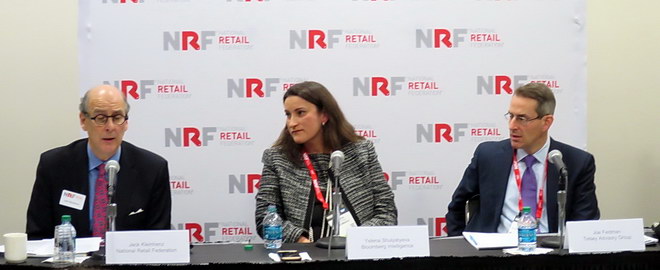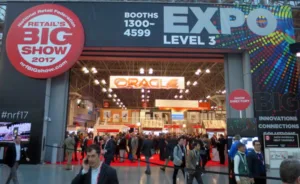The National Retail Federation (NRF) had their 2017 Big Show in New York’s Javits Convention Center January 15 -17. This is not a new thing – the NRF and its trade show have been around for 106 years. It is a pretty big show, with 34,432 attendees, including 25,891 from the US and 8541 foreign visitors, as of 11:00 on the 16th. According to Ana Serafin-Smith, Sr. Director, Media Relations, the total reached about 35,000 by the show’s end. There were about 512 exhibitors. In addition to the trade show, there were 15 keynote sessions including 32 speakers. The conference program also included numerous Exhibitor Insight and Breakout Sessions on different aspects of retail.
Entrance to the NRF Big Show upper level exhibits
The NRF and their Big Show focused on brick-and-mortar stores, not on-line retailing. The exhibitors were not the retailers themselves but the businesses selling products, services and software to the retail industry. According to the NRF, 95% of all retailers operate just one location and 98% of all retail businesses employ less than 100 people, but these small businesses were not the target of the Big Show exhibitors. Mostly they were targeting the large, mulit-location chains and brands that sold through these large chains. You could hardly talk to an exhibitor without their rep mentioning Wal-Mart.
Economic Retail Panel
 NRF Economic Panel. L. to R: Jack Kleinhenz, Chief Economist for the NRF, Yolena Shulyatyeva, Senior US Economist at Bloomberg Intelligence and Joe Feldman, Senior Managing Director with the Telsey Advisory Group
NRF Economic Panel. L. to R: Jack Kleinhenz, Chief Economist for the NRF, Yolena Shulyatyeva, Senior US Economist at Bloomberg Intelligence and Joe Feldman, Senior Managing Director with the Telsey Advisory Group
I focused on the trade show exhibition during my visit to the NRF Big Show, not the sessions. I did attend one session, however, a press-only briefing titled the “Economic Retail Panel.” Panelists were Jack Kleinhenz, Chief Economist for the NRF, Yolena Shulyatyeva, Senior US Economist at Bloomberg Intelligence and Joe Feldman, Senior Managing Director with the Telsey Advisory Group. Mr. Kleinhenz authored a report released for NRF members on Jan 13th and a summary of it is posted here. While retail in general was up 4% in 2016, sales at electronics and appliances stores decreased 2.3% unadjusted year-over-year. Not surprisingly, online and other non-store sales were up significantly and increased 12.6% unadjusted year-over-year. This growth in on-line sales represented a significant part of the overall growth of retail sales, about 1.2% of the overall 4% growth. Among brick-and-mortar stores, department stores fared the worst with a 7% Y/Y decline and health and personal care stores fared the best with a 6.7% Y/Y increase.
All of the panelists said that 2017 was a very difficult year to forecast, based on factors such as OPEC, China, European elections and, the elephant in the woodshed, Donald Trump, and his approach to international trade. Nevertheless, they were all cautiously optimistic for 2017. None of them expected a recession and their forecasts for retail growth for the year were in the range of 2% – 4%. Feldman pointed out that malls in the US were doing very poorly and big box stores were not doing well compared to other stand-alone stores and on-line sales. He forecast a 4% growth outside of malls and big box (which would be lower than 4% and are likely to show a net loss) and on-line (which would be higher than 4% and could be higher than the 12.6% growth in 2016).
All of the panelists agreed there were several factors leading to the relatively robust 2016 results and the good forecasts going forward. These good results were based on wage growth and low unemployment leading to people having more money to spend. The same factors led credit companies to extend more credit, which in turn led to more retail sales.
Modest inflation is seen as desirable by both the Federal Reserve and the panelists. Two factors have contributed most to inflation recently in the US: rent increases and the increase in the cost of health care. Both the Fed and the panelists would like to see a broader-based modest inflation and see this as helping the economy and, ultimately, retail sales.
While on-line retail sales perhaps gets the most press and showed the greatest increase year-over-year, Jack Kleinhenz said 90% of retail sales in the US were in-store and only 10% were on-line. This relatively small total for on-line sales allows it to have a very high Y/Y growth. At the trade show, however, it was obvious that all brick-and-mortar retailers were looking over their shoulders at their on-line competitors and hoping to grab a piece of the on-line action themselves.
Amazon has announced it’s first brick-and-mortar store to be opened in Seattle soon. The panelists were divided over whether this represented a limit to the possibilities of on-line retail and Amazon wanted a piece of the action for in-store sales; or if this was more a market research project where Amazon wanted to be in closer touch with consumers. Another possibility the panelists didn’t mention, but I foresee, is that this is a demonstration store for Amazon’s grab-and-go technology with no checkout. Once this technology is proven, Amazon could then sell it to convenience stores, a market that Amazon’s on-line approach is not likely to penetrate.

